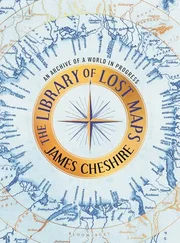
Midway through his handsomely illustrated study of mapmaking, Cheshire quotes diarist Harold Nicolson’s eyewitness account of President Woodrow Wilson kneeling over a map at the Paris Peace Conference of 1919, tracing new borders with his finger. The scene captures the book’s central concern: our enduring desire to organize the world through cartography. As the writer Peter Turchi has noted—a line Cheshire quotes—“The first lie of a map, also the first lie of fiction, is that it is the truth.” A professor of geographic information and cartography at University College London, Cheshire writes from inside the university’s Map Library, a warren of drawers containing 40,000 maps. He is an infectious guide, tracing how maps evolved from hand-tinted curiosities to instruments of science, propaganda, and power. During World War II, the Allies printed billions of map sheets and raided Axis archives for more, including nine tons seized from a single German publisher. Yet even the most precise charts could not capture the mud and confusion of the trenches; tidiness, he shows, often conceals chaos. Victorian mapmakers such as George Bellas Greenough and Heinrich Berghaus turned geography into both art and ideology. Ethnographic maps hardened into justifications for empire and war, while national atlases—like Finland’s in 1899—helped invent the very nations they depicted. Not everyone approved of cartography’s instinct to capture a changing world. When the art critic John Ruskin ordered a map from Stanfords of Covent Garden (still in business), he insisted it omit the new railway lines, calling them the “oddest” of “stupidities of modern education.” To “tidy the map,” Cheshire reminds us, is to risk mistaking lines on paper for the real world they seek to contain.

